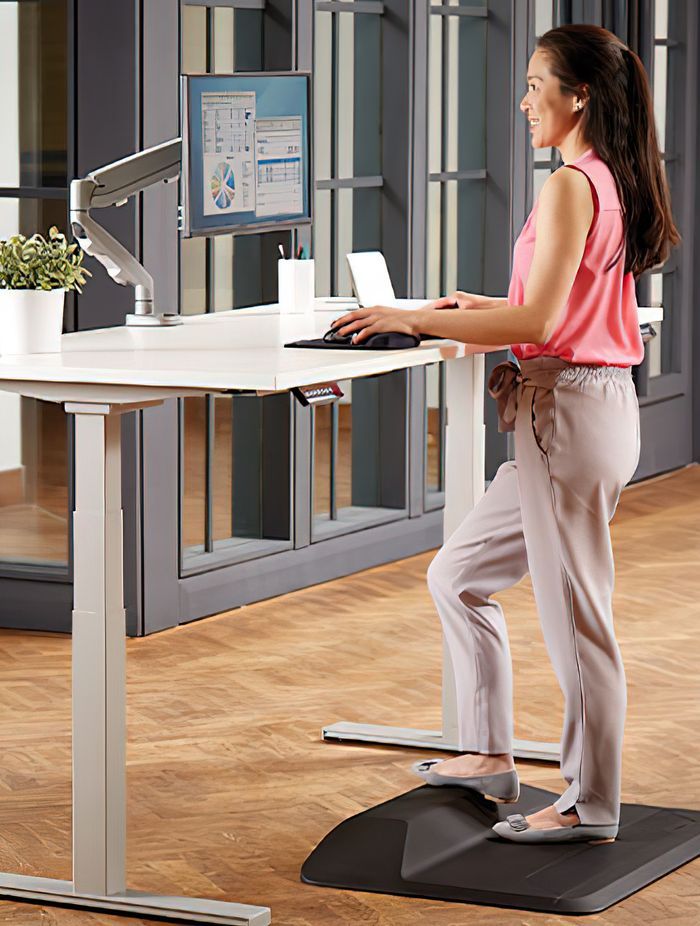Health Impact of Sedentary Working

The hidden hazards of sitting for too long
To become as happy, healthy and productive as possible, one of the things we all need to think about is how long we're sitting for each day.
Many desk-based workers are among the most likely to have a stationary lifestyle, spending around ten hours a day sitting<sup>1</sup>, either in front of the computer, having lunch at their desk, in front of the TV or glued to a device at home.
Unfortunately, sitting for long stretches every day is far from ideal for our health. Here’s why:
Bad for backs
One of the most common causes of lower back pain is postural stress, which can come from a bad sitting posture.
According to Cornell University’s Department of Ergonomics, sitting with poor posture can create up to 90% more pressure on our backs compared to standing, and this can lead to musculoskeletal injuries. These kinds of injuries saw UK sufferers take an average of 14 days<sup>2</sup> each off work in 2017/18, according to the Health and Safety Executive.
Health hazards
Studies have linked excessive sitting with obesity, type 2 diabetes and some types of cancer, including colon and endometrial<sup>3</sup>.
However, there are several things we can do to make things better. These include:

Being active
In her research, Dr. Joan Vernikos, former director of NASA’s Life Sciences Division and author of the 'Sitting Kills, Moving Heals’, discovered that movement is essential to good health.
She found that in weightlessness, astronauts, who are far fitter than the average adult, seemed to rapidly age, with their muscles, bones and overall health dropping to the same level as elderly people. Vernikos also discovered that resting, or not moving, caused the same health problems as the extended weightlessness of astronauts. She believes this is because humans are not designed to sit, and our bodies should be moving most of the time.
In terms of how often, and for how long, we move, the latest research (April 2019) from the University of Sydney has found that a weekly dose of at least 150 minutes of physical activity could substantially reduce or offset the mortality risks faced by people who sit for over six hours a day.
Another rule of thumb, when you are working at a desk all day, is to frequently change postural positions and take movement micro-breaks for every 30 minutes of sitting.
Perfecting your posture
It’s hard to avoid sitting all the time, so when you do, make sure you’re seated comfortably and safely.
Your back should be supported by the back of your chair or a back rest so that you don’t need to lean forward. If you lean forward from your lower back, this can put even more pressure on the vertebrae of your lower spine as it compresses your disks.
Your eyes should also be level with the top of your monitor screen. Any slight angle forward can place a strain on the muscles of your neck and upper back. The more you need to lean your head forward, the more work your neck and upper-back will need to do.
Your elbows should also be by the side of your body. Moving your arms forward to write or type all day, every day, will take its toll over time.
Standing up
The best way of working is to add movement to your working day. Sit-stand desks or desk converters allow you to alternate between sitting with standing at work and increase your movements. Find out more about the benefits of standing up to work here with a sit stand converter here.
DISCOVER WORKSPACE ACCESSORIES
Sources:
<sup>1</sup> https://www.washingtonpost.com/news/wonk/wp/2015/06/02/medical-researchers-have-figured-out-how-much-time-is-okay-to-spend-sitting-each-day/?noredirect=on&utm_term=.e4844358118b <sup>2</sup> http://www.hse.gov.uk/statistics/dayslost.htm <sup>3</sup> https://www.livescience.com/46345-prolonged-sitting-risk-cancers.html https://www.nhs.uk/live-well/exercise/why-sitting-too-much-is-bad-for-us/ https://sydney.edu.au/news-opinion/news/2019/04/23/can-physical-activity-offset-the-health-risks-of-too-much-sitting.html
